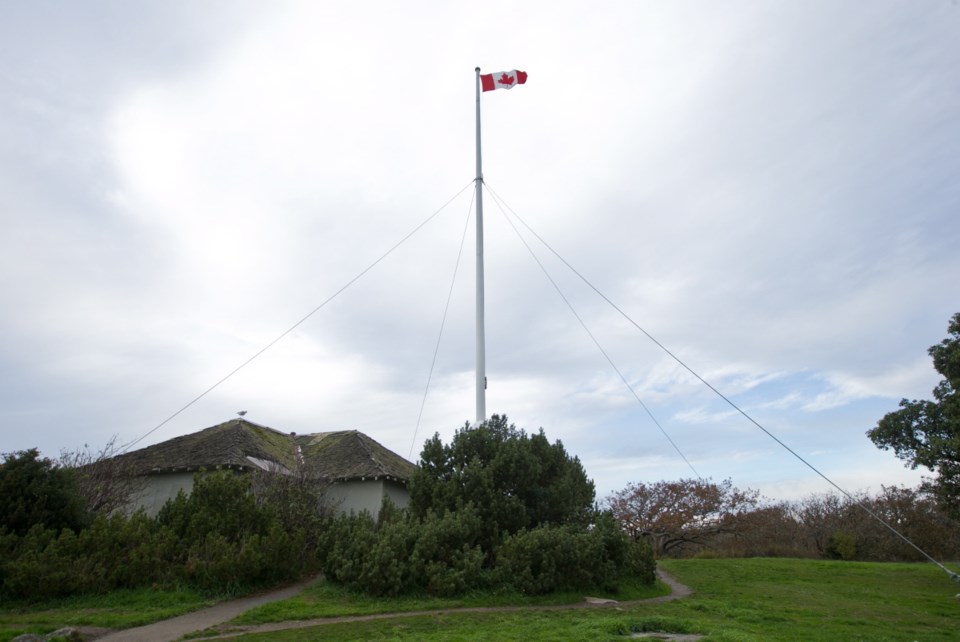Victoria is being irresponsible by letting the Beacon Hill Park Checkers Pavilion suffer “demolition by neglect,” says Coun. Ben Isitt, who would like to see the historic building restored.
“I hope we refurbish it. I think it’s an asset right in the heart of Beacon Hill Park. I think many residents have fond memories of using that facility for recreation,” Isitt said.
“I actually think it’s irresponsible of the city to basically be overseeing a process of demolition by neglect.”
The pavilion was built atop Beacon Hill in 1936 in part as a project for relief workers during the Great Depression. It now sits, as it has for years, boarded up and all but forgotten.
Enjoyed for decades as a lookout with breathtaking views of the Olympic Mountains, where folks could idle the day away gazing out in wonderment, or perhaps feign exercise by using sticks to push large checkers around a giant checkerboard painted on the floor, the neglected pavilion didn’t even make it onto the recently completed facilities assessment report of city buildings.
“It sort of jumps out as being one of the few city facilities that isn’t being properly stewarded and maintained,” Isitt said.
Over the years, it has been the subject of countless discussions. Suggestions have included reconstructing it into an upscale tea room, housing aeolian wind harps to transform it into a “harmonic sanctuary,” and restoring it to its original use as a lookout and checker venue.
But for all the talk, there has been no action.
Given that it was constructed in the middle of a Garry oak ecosystem, some say it should be demolished.
In 199, there was an offer of a one-day, “barn-raising” style of reconstruction that was ultimately rejected by the council of the day.
Councillors heeded police warnings that a new building would be a target for vandals.
Isitt believes the biggest impediment is the Beacon Hill Park trust, which established the park in 1882 and which restricts commercialism in the park.
He said ideas for commercial use have come and gone, but council has not seriously looked at non-commercial uses.
He said he has “absolutely no interest” in exploring any commercial activities in the park.
“But I think there’s a number of uses we could look at — a nature house for children and families. It could involve a nice quiet sitting spot for seniors and other members of the community or going back to a checker pavilion.
“There’s resource implications because you’d need a level of supervision and ongoing maintenance, but I think those are reasonable expenditures for the city to look at.”
Coun. Geoff Young said there would be more implications to restoring the pavilion than first meet the eye.
“It’s a tough building to deal with,” Young said. Commercial activities such as a tearoom wouldn’t be allowed, he noted.
With the city already grappling with such issues as people camping in parks, it’s not feasible to restore it and leave it open as a shelter or for use as a checkers pavilion, Young said. “So it’s a problem.”
Isitt disagreed. There are a number of pavilions or picnic shelters throughout the region open to the public that don’t cause problems, and any issues that might arise could be “completely managed,” Isitt said.
The trust would be an issue only if a commercial operation were proposed for the pavilion, Coun. Chris Coleman said.
“At the moment, it acts as an attractive nuisance. It’s been misused. It’s been vandalized,” said Coleman, adding that there’s probably no call in today’s world for a checkers pavilion.
“So you have to think what facility would work up there. It could be sort of an outdoor interpretive centre — a number of different things have been suggested.
“But who pays for it? And who maintains it?”



-thumb.png;w=120;h=80;mode=crop)